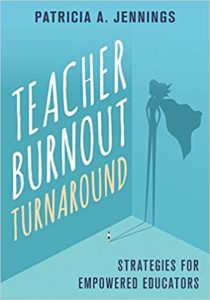Re-envisioning Teacher Responses to Burnout
Teacher Burnout Turnaround: Strategies for Empowered Educators
By Patricia A. Jennings
(W. W. Norton and Company, 2021 – Learn more)
Reviewed by Ashley Falkos

Patricia Jennings’ book is relevant to any teacher who feels like the pandemic has affected learners and teachers alike.
Teachers, as a whole, are vastly burnt out and losing motivation to continue the hard work they get paid very little to do. The burnout crisis has led to a teacher shortage, as professionals in our field are leaving in droves. In fact, according to Jennings, 25% of all teachers quit last year.

The author encourages educators to realize that we are a workforce of over three million dedicated professionals and empowers us to feel that we have the knowledge and capacity to make major changes in an outdated educational system.
Our students are learning in a 21st century environment, and often we are preparing them for jobs that don’t even exist currently. Furthermore, are we teaching our students mindfulness to deal with the stressors of the post-pandemic world as they move forward? Are we considering our own mental health as teachers working in what often seems like a pressure cooker set on high?
The book is laid out in three parts. Here are the main takeaways from each section:
Addressing Teacher Stress and Burnout
How did we get here? This provides a brief history of the education system in America and points out that we are still operating with an old factory model, despite how much our world has changed. It addresses the stress educators are prone to: managing emotions, fitting in curriculum, and making hundreds of decisions daily.
Part One concludes with ways to build inner resilience. This is not surprising coming from Jennings, who was named “One of the Top Mindfulness Researchers You Should Know.” I appreciated that she acknowledges the problems most teachers sarcastically joke about, but then she offers a solution on ways to cope.
Preparing for Transformative Change
Jennings also acknowledges teacher mindset, which is very interesting from a psychological standpoint. Are we telling ourselves “scripts,” based on what we think teaching is supposed to be, or is what we’re doing actually fit today’s reality? She often refers to “mind traps” and how to overcome them as educators who have been asked to teach in an archaic system during the 21st century.
Empowering Teachers
We have the power to make change as teacher leaders. Jennings raises questions such as “What does our current professional development look like opposed to what should it look like to be effective?” I particularly like how she concluded with an ideal school as an example that empowers not only educators but students as well.
By the time I finished Teacher Burnout Turnaround, I felt inspired and ready to take on the aftermath of two years of pandemic panic. This book has motivated me to prioritize the social-emotional needs of my students as well as to be aware of my own mindset.
If you need some motivation and are feeling burnt out after an incredibly taxing year, pick this new book up today!
Ashley Falkos (@AshleyFalkosRS) is a Reading Specialist and Literacy Coach in Geneva CUSD 304 (Illinois). She has six years of experience as an elementary classroom teacher and has been in her current position for eight years at the middle school level. She has presented at the Illinois Reading Council and the Illinois Council of Instructional Coaches. She enjoys promoting literacy as an advanced leader with UBAM and spending time with her two little girls – reading, of course!

































